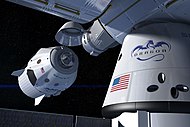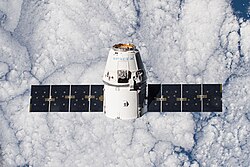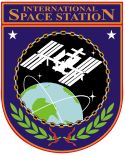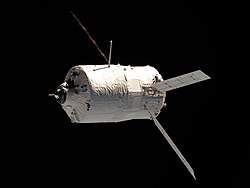SpaceX CRS-10
| SpaceX CRS-10 | |||
 | |||
| Beställare | NASA | ||
|---|---|---|---|
| Tillverkare | SpaceX | ||
| Modell | Dragon | ||
| Farkost | C112 | ||
| Operatör | SpaceX | ||
| Färdens tid | 28 dagar, 7 minuter | ||
| NSSDC-ID | 2017-009A[1] | ||
| Uppskjutning | |||
| Startplats | Kennedy Space Center LC-39A | ||
| Raket | Falcon 9 v1.2 | ||
| Uppskjutning | 19 februari 2017, 14:39:00 UTC | ||
| Landning | |||
| Landningsplats | Stilla havet, 320 km SV om Long Beach, Kalifornien | ||
| Landningstid | 19 mars 2017, 14:46:30 UTC | ||
| Omloppsbana | |||
| Banlutning | 51,6° | ||
| Dockning | |||
| Rymdstation | ISS | ||
| Greppad | 23 februari 2017, 10:44 UTC | ||
| Dockning | 23 februari 2017, 13:12 UTC | ||
| Dockningsport | Harmony, nadir | ||
| Ur dockning | 18 mars 2017, 21:20 UTC | ||
| Släppt | 19 mars 2017, 09:11 UTC | ||
| Tid dockad | 23 dagar, 8 timmar, 8 minuter | ||
| Last upp | |||
| Upp | 2 490 kg[2] | ||
| Tryck satt | 1 530 kg | ||
| Tryck löst | 960 kg | ||
| Kronologi | |||
| |||
SpaceX CRS-10 eller SpX-10 var en obemannad flygning till Internationella rymdstationen med SpaceX:s rymdfarkost Dragon. Farkosten sköts upp med en Falcon 9-raket, från Kennedy Space Center LC-39A, den 19 februari 2017. Farkosten greppades av Canadarm2 den 23 februari och dockades med Harmonymodulen.
Farkosten kopplades loss från Harmonymodulen den 18 mars 2017 och släppte Canadarm2 den 19 mars 2017 och lämnade rymdstationen. Knappt sex timmar senare återinträdde den i jordens atmosfär och landade i Stilla havet utanför USA:s västkust.
Efter uppskjutningen lyckades SpaceX att landa bärraketens första steg, på Landing Zone 1, några kilometer från uppskjutningsplatsen.
Uppskjutningen var den första av en privat raket från LC-39A vid Kennedy Space Center.
18 februari
Vid ett försök att skjuta upp farkosten den 18 februari 2017 avbröts nedräkningen 13 sekunder före uppskjutningen på grund av ett problem i styrningen av raketens andra steg.[3]
Inflygning
Den 22 februari 2017 avbröt farkostens dator den pågående inflygningen mot rymdstationen.[4] Dockningen sköts fram ungefär 24 timmar.[5]
Källor
Referenser
- Den här artikeln är helt eller delvis baserad på material från engelskspråkiga Wikipedia, tidigare version.
Noter
- ^ ”NASA Space Science Data Coordinated Archive” (på engelska). NASA. https://nssdc.gsfc.nasa.gov/nmc/spacecraft/display.action?id=2017-009A. Läst 2 mars 2020.
- ^ ”SpaceX CRS-10 Mission Overview” (på engelska). NASA. https://www.nasa.gov/sites/default/files/atoms/files/spacex_crs-10_mission_overview_0.pdf. Läst 19 februari 2017.
- ^ ”blogs.nasa.gov” (på engelska). NASA. https://blogs.nasa.gov/spacex/2017/02/18/launch-scrubbed/. Läst 18 februari 2017.
- ^ ”@NASA” (på engelska). NASA. https://twitter.com/NASA/status/834336113884012544. Läst 22 februari 2017.
- ^ ”@SpaceX” (på engelska). SpaceX. https://twitter.com/SpaceX/status/834346217853194243. Läst 22 februari 2017.
| ||||||||||||||||||||||||||||||||||||||||||||||||||||||||
| ||||||||||||||||||||||||||||||||
| ||||||||||||||||
Media som används på denna webbplats
NASA's insignia for the ninth Commercial Resupply Services flight to the ISS, which will be taking up the International Docking Adaptor-2.
This image, photographed by one of the Expedition 42 crew members aboard the International Space Station, shows the SpaceX Dragon cargo craft approaching on Jan. 12 2015 for its grapple and berthing and the start of a month attached to the complex. Dragon carried more than 2 ½ tons of supplies and experiments to the station.
NASA's insignia for SpaceX's eleventh Commercial Resupply Services flight to the International Space Station.
Also includes NICER, MUSES and ROSA.
ISS021-E-017623 (30 Oct. 2009) --- Backdropped by a cloud-covered part of Earth, the unpiloted Japanese H-II Transfer Vehicle (HTV), filled with trash and unneeded items, departs from the International Space Station. European Space Agency astronaut Frank De Winne, Expedition 21 commander; NASA astronaut Nicole Stott and Canadian Space Agency astronaut Robert Thirsk, both flight engineers, used the station's Canadarm2 robotic arm to grab the HTV cargo craft and unberth it from the Harmony node's nadir port. The HTV was successfully unberthed at 10:18 a.m. (CDT) on Oct. 30, 2009, and released from the station's Canadarm2 at 12:32 p.m.
NASA's insignia for the tenth Commercial Resupply Services flight to the International Space Station, with "mousetronauts."
Also includes the Stratospheric Aerosol and Gas Experiment (SAGE) and a Lightning Imaging Sensor, designated STP-H5.
A Progress supply ship linked up to the orbiting International Space Station (ISS) at 3:48 GMT, November 18, bringing Expedition 1 commander William M. Shepherd, pilot Yuri P.
Gidzenko and flight engineer Sergei K. Krikalev two tons of food, clothing, hardware and holiday gifts from their families. The photograph was taken with a 35mm camera and the film was later handed over to the STS-97 crew members
for return to Earth and subsequent processing.Författare/Upphovsman: SpaceX, Licens: CC0
This artist's concept shows a SpaceX Crew Dragon docking with the International Space Station as it will during a mission for NASA's Commercial Crew Program. NASA is partnering with Boeing and SpaceX to build a new generation of human-rated spacecraft capable of taking astronauts to the station and expanding research opportunities in orbit.
Författare/Upphovsman: Space Exploration Technologies Corp., Licens: CC0
The 2018 version of the Big Falcon Rocket at stage separation: Starship (foreground) and Super Heavy (background)
Backdropped by a cloud-covered part of Earth, the Orbital Sciences' Cygnus cargo craft approaches the International Space Station, photographed by an Expedition 40 crew member. The two spacecraft converged at 6:36 a.m. (EDT) on July 16, 2014.
ISS026-E-037172 (24 Feb. 2011) --- Surrounded by the blackness of space, the European Space Agency's "Johannes Kepler" Automated Transfer Vehicle-2 (ATV-2) approaches the International Space Station. Docking of the two spacecraft occurred at 10:59 a.m. (EST) on Feb. 24, 2011.
















